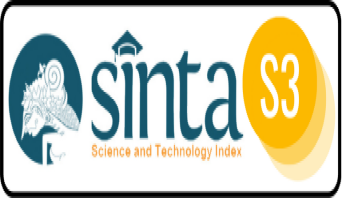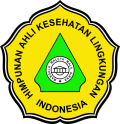PENGGUNAAN LIDAH BUAYA (Aloe vera) SEBAGAI KOAGULAN ALAMI UNTUK MENURUNKAN KEKERUHAN AIR
DOI:
https://doi.org/10.26630/rj.v15i1.2152Keywords:
Aloe vera, clean-water, coagulant, turbidityAbstract
Dug wells are the most widely used clean water facilities in the community, but they often have high turbidity levels. So that processing must be done using a coagulant material. Aloe vera is a natural ingredient that contains complex carbohydrates, sugars, and mucilages which can bind particles in water. This study aims to determine the effect of variations in Aloe vera doses on reducing water turbidity. This study used a completely randomized design (CRD) with three dose variations (0.1 ml, 0.2 ml, and 0.3 ml) and six repetitions. A total of 500 ml of raw water from resident wells was used for each treatment. The results showed that at a dose of 0.1 ml, the turbidity decreased by 3.7%, from 41.1 NTU to 39.6 NTU (SD = 0.54). The dose was 0.2 ml, decreased by 6.8% (38.3 NTU; SD = 1.54), and the dose was 0.3 ml decreased by 13.9% (35.4 NTU; SD = 1.02). Statistically, it showed a significant difference in turbidity in each treatment group (p-value <0.05). Research has shown that Aloe vera can be used as a natural coagulant, but further research is needed to determine the correct dosage.
References
Furnawanthi, I., 2002. Khasiat dan manfaat lidah buaya. AgroMedia Pustaka, Jakarta.
Gabriel. J. F, 2001. Fisika Lingkungan. Penerbit Hipokrates, Jakarta.
Idris, J., Som, A.M., Musa, M., Hamid, K.H.K., 2013. Dragon fruit foliage plant-based coagulant for treatment of concentrated latex effluent: Comparison of treatment with ferric sulfate. Journal of Chemistry 1–7.
Kemenkes, R.I., 2017. Peraturan Menteri Kesehatan Republik Indonesia Nomor 32 Tahun 2017 Tentang Standar Baku Mutu Kesehatan Lingkungan Dan Persyaratan Kesehatan Air Untuk Keperluan Higiene Sanitasi, Kolam Renang, Solus Per Aqua dan Pemandian Umum, Kemenkes RI.
Kementerian Kesehatan RI, 2017. Peraturan Menteri Kesehatan Republik Indonesia nomor 32 tahun 2017 tentang Standar Baku Mutu Kesehatan Lingkungan Dan Persyaratan Kesehatan Air Untuk Keperluan Higiene Sanitasi, Kolam Renang, Solus Per Aqua, Dan Pemandian Umum.
Maharani, A., Prambudi, A.R., Udyani, K., 2020. Pengolahan air sumur di daerah Simolawang menggunakan metode koagulasi dengan koagulan aloevera. Seminar Nasional Sains dan Teknologi Terapan 1, 315–322.
Mujariah, Abram, P. hengki, Jura, M.R., 2016. The Use of Aloe Vera Gel ( Aloe Vera ) As A Natural Coagulant in Well Water Purification at The Sausu Tambu Village District Sa. Jurnal Akad. Kim 5, 16–22.
Musriyah, 2016. Manfaat Air Bagi Manusia, Hewan dan Tanaman [WWW Document]. Dipetik 18 April 2017, dari Website Resmi Pemerintah:
Permatasari, T.J., 2013. Optimasi Penggunaan Koagulasi Dalam Proses Penjernihan Air. jurnal Sains dan Seni 2, A-7.
Pichler, T., Young, K., Alcantar, N., 2012. Eliminating turbidity in drinking water using the mucilage of a common cactus. Water Science & Technology: Water Supply. 179–186.
Pranata, M.F., A., S., Raharja, M., 2019. Perbaikan Kualitas Air Menggunakan Gel Lidah buaya (Aloe vera). Jurnal Kesehatan Lingkungan 16, 763–790.
Puspitasari, D., Setiawan, A., Dewi, T.U., 2013. Penggunaan Lidah Buaya sebagai Biokoagulan di Industri Minyak 141–144.
Rifa’i J., 2007. Pemeriksaan kualitas air bersih dengan koagulan alum dan PAC di Ipa Jurug PDAM Kota Surakarta.
Taufiqullah, T., 2020. Pengaruh Suhu Terhadap Kualitas Air [WWW Document]. TNeutron.
Vijayaraghavan, G., Shanthakumar, S., 2015. Efficacy of Moringa oleifera and Phaseolus vulgaris (common bean) as coagulants for the removal of Congo red dye from aqueous solution. Journal of Materials and Environmental Science 6, 1672–1677.
Yawaritsa, Y., Daud, S., Asmura, J., 2019. Penyisihan Warna dan Zat Organik (KMnO4) pada Air Gambut dengan Biokoagulan Gel Lidah Buaya. JOM FTEKNIK 6, 1–8.
Downloads
Published
How to Cite
Issue
Section
License
Copyright (c) 2021 Ruwa Jurai: Jurnal Kesehatan Lingkungan

This work is licensed under a Creative Commons Attribution-NonCommercial 4.0 International License.

Ruwa Jurai: Jurnal Kesehatan Lingkungan is licensed under a Creative Commons Attribution-NonCommercial 4.0 International License.
Authors who publish with this journal agree to the following terms:
- Authors retain copyright and grant the journal right of first publication with the work simultaneously licensed under a Creative Commons Attribution-Non Commercial License that allows others to share the work with an acknowledgment of the work's authorship and initial publication in this journal.
- Authors are able to enter into separate, additional contractual arrangements for the non-exclusive distribution of the journal's published version of the work (e.g., post it to an institutional repository or publish it in a book), with an acknowledgment of its initial publication in this journal.
- Authors are permitted and encouraged to post their work online (e.g., in institutional repositories or on their website) prior to and during the submission process, as it can lead to productive exchanges, as well as earlier and greater citation of published work.









